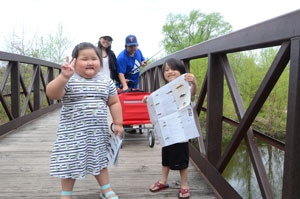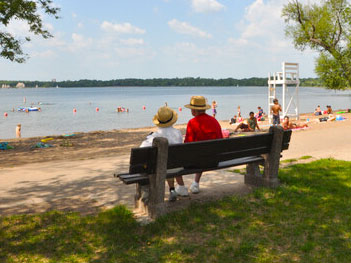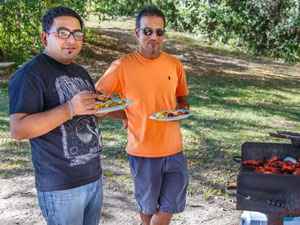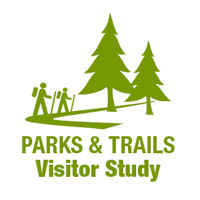Regional Parks and Trails System Visitor Study
Jump to full report and chapters
 Minnesota is home to one of the best regional park systems in the country. The Metropolitan Council and partner park agencies want to keep it that way. It’s a key factor in attracting and retaining new residents, which supports the economic vitality of the region.
Minnesota is home to one of the best regional park systems in the country. The Metropolitan Council and partner park agencies want to keep it that way. It’s a key factor in attracting and retaining new residents, which supports the economic vitality of the region.
People love the region’s parks and trails. We know that because they told us. But they also suggested ways the region can do better. Our parks, trails, and structures need investments for repairs and upgrades to both modernize the system and take care of what we have.
According to the 2021 Parks and Trails Visitor Study, visitors are highly satisfied with regional parks and trails. This doesn’t just happen; it takes strategic partnerships with all 10 partner agencies and a shared vision to follow that make people feel this way.
Working together yields a more strategic approach than the Met Council could create alone. Parks planning brings together partner agencies, public officials, and engaged members of the community in the ongoing design and planning processes for current and future park and trail resources.
“People want a well-maintained and high-quality regional parks and trails system. This means smooth, pothole-free trails, clean, open bathrooms, and drinking fountains that work.”
- Emmett Mullen, senior manager of regional parks planning
In the 2021 study, park visitors across the region expressed high levels of satisfaction with regional parks and trails. For parks and trails systemwide, 88% of visitors reported that the facilities on the day of their visit were “excellent” or “very good.” While this statistic is something to be proud of, satisfaction is down from 95% in 2016. When regional parks and trails are not accessible and aren't adequately modernized with bathrooms and other baseline amenities, satisfaction and use diminish.

Visitor recommendations connect with current concerns in the regional system
Summer 2021 was the hottest on record for the Twin Cities. Visitors’ recommendations for facilities reflected this, with desire for more shade and water access. As the regional trail system continues to expand, trail maintenance also requires investment. Visitors care about basic amenities like bathrooms and water access. They value a natural setting with high water quality and free of litter.
For parks, the top suggestions for improvement were all issues related to “general maintenance” (20%), followed by “nothing at all” (16%). The most popular suggestions were basic improvements like bathrooms and drinking water access, trail conditions, and improved signage/information.
These findings point to a long period of limited funds for modernization. Throughout the pandemic, more people have headed outdoors to use our parks and trails. The frequency and persistence of inland flooding, extended heat waves, and freeze-thaw cycles have intensified, all contributing to a growing need for repairs and improvements.
More information on visitor satisfaction (PDF)

Popular activities in parks and on trails
“It’s worth diving into this to both understand the general activities that everyone loves to do in parks and trails, but also as we’re thinking about what kind of programming investments creates an equitable system, understanding that there are differences by social characteristics,” notes principal researcher Darcie Vandegrift.
All visitors, regardless of social characteristics, enjoyed a diverse range of activities. Hiking, walking, relaxing, observing nature, biking, and meeting up with friends were among the most popular activities. Biking is most popular on trails, though hiking, walking, jogging, running, and observing nature are common activities as well.
More information about popular activities (PDF)

Visitor demographics and equitable use
The Twin Cities regional park and trail system continues to rank high nationally for an impressive commitment to preserving open space and offering recreational amenities. The 2040 Regional Parks Policy Plan commits the Met Council to work to “strengthen equitable usage of regional parks and trails by all our region’s residents.” To this end, Met Council research must identify to what extent visitation patterns reflect the region’s population. Additionally, understanding how underserved populations enjoy the regional system can help inform future investment decisions.
Exploring visitation patterns reveals that not all population groups equally experience the benefits of public investment in parks and trails. Young people and BIPOC visitors visited in lower proportion than would be expected given their proportion in the regional population. Men and women visited parks in expected proportion for the population, but a gender gap existed for trail use. The survey asked additional demographic questions including nonbinary and transgender identities, disability status, household income, and languages spoken at home. These survey findings show linguistic, ability, and gender identity diversity in all 10 park agencies. Disparities in park and trail visitation by age, race, ethnicity, income, and gender persist in the Twin Cities.
More information about visitor demographics (PDF)
Key takeaways by park agency staff
Staff from the 10 regional park partners and Met Council staff met to discuss visitor study findings over the summer of 2022. Reviewing the data, they identified important implications from the study:
- Adequate, sustainable funding for operations and maintenance of the system is necessary to provide the level of service visitors want. The system requires regular investment from the state, regional, and local levels to maintain visitor satisfaction. Deferring operations and maintenance investments can result in degraded facilities and trigger the need for greater capital investment.
- Bathroom and water access are key to making new and underserved visitors comfortable in the regional park system.
- When regional parks and trails are not adequately maintained, use will diminish.
- Efforts are underway to create a park and trail system that is welcoming to underserved population groups, and these efforts need to be expanded and deepened. Operations and maintenance funding as well as programming funding are important investments to enhance equitable use.
- Visitors have less satisfaction with trails, and trails have greater social disparities in visitor use, than parks. We need to address trail issues in the areas of policy, research, and funding.

Full report and chapters
About the survey
The Met Council partnered with Wilder Research to conduct the 2021 visitor study to measure satisfaction with the regional park system. This information will be used to inform the 2050 Regional Development Guide, evaluate and strengthen equitable usage of regional parks and trails, and to help determine formulas for park and trail funding.
5,405 visitors accepted the invitation to participate in the survey during their park or trail visit, a response rate of 52%. Visitors were surveyed at 114 park, trail, park reserve, and special recreation feature units across the regional system.
Surveys were administered May 31 to September 12, 2021, in proportion to park or trail visitation in 2019. Met Council staff checked the data for errors and analyzed the results. Staff from all 10 implementing agencies participated in a summer workshop series to add context to the results.